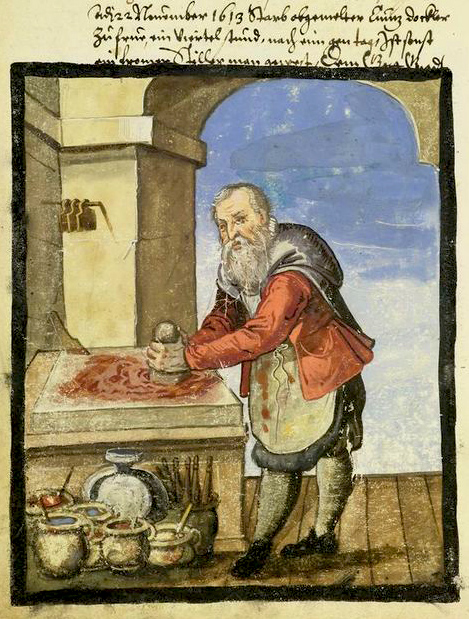
The Tempera Painter's Toolbox
The creation of an egg tempera panel requires special tools, many of them different from those used in other painting techniques. These tools have evolved little over the past thousand years. Here we take a look at the use and history of the basic components found in the egg tempera artist's toolbox.
WOOD Wooden panels are the traditional support  for egg tempera as they are easily worked and quite strong. They are also absorbent, which helps foster a permanent bond between the board and the gesso.
for egg tempera as they are easily worked and quite strong. They are also absorbent, which helps foster a permanent bond between the board and the gesso.
Italian tempera panels were traditionally painted on soft woods such as poplar, linden or willow. In Northern Europe, oak panels were most common. Artists prepared the wood by first sawing it into planks which were spread in the rafters of a barn to season. Over a year or two, the wood was periodically turned to encourage even drying on all sides. The planks were then planed flat and allowed to dry again — a procedure that was repeated, sometimes for years, until the panel was stable and completely dry. In the workshop, the wooden planks were then glued together to form a panel of the proper size. Moldings were also glued on, and, for very large panels, a wooden bracing (called a cradle) was attached to provide added stability.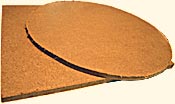
untempered hardboard
Today, with air-conditioning and central heating, indoor humidity levels fluctuate more than in Medieval times. Also, most wood is now kiln-dried — a process which cooks the water quickly from green wood, leaving it too dry and easily affected by moisture. This causes wood to be more prone to warping and cracking. Wood panels also have a grain which can mar their surface as well as being rather heavy, bulky and time-consuming to prepare.
The preferred support today is one-quarter-inch, untempered hardboard. This material is created from shredded wood and waste sawdust which is treated to separate it into individual fibers and then slurried with water. The fibers are then naturally 'glued' back together at very high temperature and pressure to create an extremely dense, dry and dimensionally stable board. Hardboard resists warping, doesn't crack and expands and contracts much less than raw wooden boards. Also, large sheets can be produced, which are easily cut into any shape or size.
top of pageCHALK/WHITING 
finely ground
calcium carbonateThe egg tempera technique requires that a smooth, white, absorbant surface be created to properly adhere the gold and pigments to the wooden support.
The material used by tempera artists has always been a form of calcium carbonate — as powdered gypsum, marble dust or chalk. Today's material of choice is fine chalk, which is calcium carbonate in its purest form and one of the whitest substances available. Though unsuitable as a pigment when mixed with oil, when combined with glue as a ground in tempera, chalk retains its brilliant white color even when heated. This is crucial since the luminosity of egg-tempered pigments 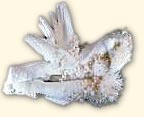
crystalline calcium carbonatedepends upon the whiteness of the ground.
Produced by finely grinding limestone to uniform particle size, chalk is inexpensive and non-toxic and has always been widely available — it was used by artists as far back as the painters of Pompeii. During the Middle Ages, it was employed in a variety of art forms including manuscript production, as a pigment and as a drawing medium.
When mixed with a binder and applied to wood, chalk creates an extremely durable and brilliant surface which can be sanded perfectly smooth.
GELATIN/RABBIT SKIN GLUE A binder, or glue, which is added to chalk to create the gesso — the white ground which is brushed onto and adheres strongly to the wooden panel.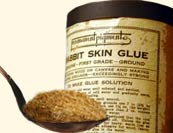
In early times, there were many different kinds of binders, produced primarily by boiling hides, bones and other animal parts. The glues derive their strength from extracted collagen (the protein of the connective tissue that also holds together tendons, bones and teeth). Parchment glue was make by cooking scraps of lamb, goat or calf skin (depending upon the local diet). Fish glue was extracted from the air bladders of sturgeons.
The best rabbit skin glue — made from the hides of French rabbits — is a very flexible glue which is among the oldest and most reliable binders available.
The glue is provided in a granular form, and must be soaked and softened in water overnight. The glue is then heated and dissolves into a liquid, which thickens into a gel as it cools. Rabbit skin glue is an exceptionally strong adhesive. It is also hygroscopic, so the gesso it makes will adjust to the moisture in the air along with the wood, ensuring a lasting bond between support and painted surface.
A good, less expensive substitute for rabbit skin glue is unflavored gelatin (a modern collagen extract from pigs and cows), which is easier to prepare and also creates a strong bond.
top of pageBRUSHES  A selection of brushes are required for panel painting. A flat, bristle brush (traditionally hog bristle) is used for applying the gesso. A wide, camel hair brush — known as gilder's tip — is used for picking up and applying loose gold to the panel. Pigments are applied with small round brushes traditionally made from animal tails, though some newer synthetic bristles also produce a good result.
A selection of brushes are required for panel painting. A flat, bristle brush (traditionally hog bristle) is used for applying the gesso. A wide, camel hair brush — known as gilder's tip — is used for picking up and applying loose gold to the panel. Pigments are applied with small round brushes traditionally made from animal tails, though some newer synthetic bristles also produce a good result.
There are two important qualities in brushes used for tempera painting. First, look for a brush with a resilient tip, one that retains a fine point and won't split or flatten out, as you need to paint with the very tip of the brush. The fine point allows you to apply color faster, as thin glazes will dry in seconds, allowing you to overlap layers of glaze quickly.
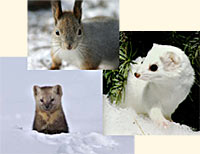
miniver, ermine and sable: animal
tails used in fine brushmakingAlso, egg tempera brushes need to retain paint in sufficient quantity and be able to feed the paint out as freely and smoothly as a pen feeds ink. This allows you to cover a large area of the panel rapidly with a thin glaze before having to refill the brush. Hundreds of overlapping strokes create the translucent, optical color-mixing effect characteristic of egg tempera.
The natural curve of the brush hair forms a reservoir to hold the paint. Certain hairs hold paint better than others. Sable brushes, which come from animals in the weasel and mink families, have excellent water-retention qualities and resiliency. This makes them spring well and hold a fine point. The Kolinsky sable hair brush, made from the winter fur of the male sable, is considered the highest quality, with an especially thick and resilient texture.
Egg tempera brushes, typically the same brushes used for watercolors, come of a variety of sizes starting from just a few hairs. The basic principal of tempera painting is control of the color. No washes or opaque colors are applied. Instead, the tempera artist applies pigment in tiny crosshatched strokes, as in pencil drawing. Tempera is a precision, detailed technique — one small panel is painted with tens of thousands of strokes.
![]() We're fortunate to have many sources of fine brushes today. In Medieval times, brush-making was a time-consuming task for the artist. A part of the procedure is explained in Cennini's "The Craftsman's Handbook" (pub. 1399):
We're fortunate to have many sources of fine brushes today. In Medieval times, brush-making was a time-consuming task for the artist. A part of the procedure is explained in Cennini's "The Craftsman's Handbook" (pub. 1399):
Take miniver tails...cooked and not raw. Take one of these tails, first pull the tip out of it, for those are the long hairs, and put the tips of several tails together, for out of six or eight tips, you will get a soft brush, good for gilding on panel... Take the straightest and firmest hairs out of the middle of the tail and gradually make up little bunches of them and wet them in a goblet of clear water... And when you have made up quite a number of bunches, put enough of them together to make up the size you want...some to fit in a vulture's quill, some to fit in a goose's quill... Put them together very evenly...take thread or wax silk and tie them up well with knots... Then take your quill – open or cut off at the end – and put these tied-up hairs into this quill...so that some of the tips will stick out... Then take a little stick of maple or chestnut tapered like a spindle and large enough to fit tightly into this quill."top of page
PIGMENTS
The art of the Medieval ages was extremely colorful, and colors were frequently used to symbolically represent particular saints, religious subjects and the heavenly realm. Painting with the rarest pigments was considered an act of devotion to God.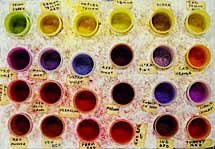
Medieval pigments came from a wide variety of natural sources — from rocks, insects, berries, flowers, sea shells, roots, bark, colored minerals and earth. Many were also created through chemical reactions, such as corrosion or burning. Artists were always experimenting with colored materials that could be crushed, ground or squeezed into a form that could be somehow adhered to the panel.
Each workshop had to procure and prepare its own pigments, and so each apprentice spent many years learning to identify, purify and grind colors. The finest colors were extremely hard to come by, with bits of the rarest blues and reds traveling thousands of miles, passing from camel caravan to ship to trader's cart along their way. Richly colored panels were often valued less for the painter's skill than for the rarity of their pigments.
The Medieval palette contained a number of typical colors, including the following:
- Reds were indispensable and the most commonly used color. From early times, a bright scarlet was made from natural cinnabar, found in Spain and Tuscany. A similar color, vermillion, was a manufactured form of cinnabar, made by heating mercury with sulfur and then collecting and grinding the vapor deposits. These deep reds were used for the robes of Cardinals and saints. A purplish-red, carmine, was made from boiling the female cochineal insect and, using a complex process, extracting the red dye. Some exotic colors spawned their own legends, such as dragon's blood, described as a red pigment formed from the mingling of blood of elephants and dragons which killed each other in battle.
- Of the blues, most common color was azure, from the copper-rich mineral azurite found throughout Europe. Extremely hard, it took great patience to grind to a fine powder, which was also hard to bind to the panel. The most prized blue was ultramarine (literally 'from beyond the sea'), made from lapis lazuli found only in the mountains of Afghanistan. Grinding lapis resulted in a blue of exceptional intensity and purity, equal in value to gold. The finest grades of ultramarine were always reserved for painting Christ and the Virgin (the color was often called Virgin Blue because of its frequent use on the Mary's robe). So highly valued, this blue was sometimes scraped from older panels and reused. The Duke de Berry numbered among his treasures two precious pots of ultramarine. Plant-derived blues such as indigo were also popular.
- Greens were important, but Medieval artists had no stable, intense green available. The mineral malachite produced a coarse pigment that was muddy and unstable. A more popular green was verdigris, produced by hanging copper plates over vats of urine or vinegar. The copper would corrode, and the green acetate would be scraped off and ground. Sap green and iris green were the most common plant-based greens, both made by extracting the plant juices and adding alum. However, the most common method of making green was by mixing yellow and blue.
- Yellow was made from the saffron flower, or from volcanic earth from the Tuscan hills. Clay for yellows, browns and oranges would be dug up, then ground to a fine powder for use. Lead tin yellow, a daffodil-colored powder, was produced by firing the oxides of lead and tin in a furnace, then collecting the dense residue.
- Tyrian Purple was a dye extracted from the whelk shell, found in Lebanon. Each snail-like fish would yield a single drop of dye.
- The principle opaque white pigment was the highly toxic lead white, formed as a corrosive crust on metallic lead sealed in a jar of sour wine. Other whites were made from bird bones burned to ash.
- Black was made in a number of ways. One was by burning twigs and peach pits or bones, then grinding the residue until it became a fine powder. Another material, known as lampblack, was produced by burning an oil flame beneath a metal dish, which deposited a film onto the dish. This black soot was scraped off and used as-is.
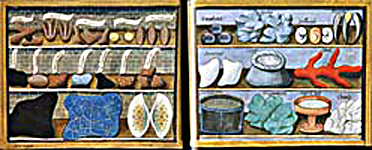
medieval illustration shows sources of pigmentsMost mineral, earth and chemical pigments were processed by washing, pulverizing and then grinding them to a smooth, fine powder or paste (a process called levigation). Traditionally, these substances were ground by placing the rough clumps on a granite or glass slab, adding water and then meticulously grinding with a glass muller. These pastes can be saved for use in airtight bottles under a layer of water. However, if colors are bought ready for use, they can also be stored dry.
GOLD LEAF 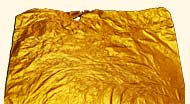
single sheet of 23k gold leafGold is one of the softest and most malleable of metals. A single gram of gold can be beaten into a sheet of over one square yard, an ounce into 300 square feet. For over 5000 years, it has been known that gold can be hammered into sheets thinner than the thinnest paper without crumbling. In this form, gold leaf has virtually no weight and is so thin that light can pass through it. Mummies from ancient Egypt have been exhumed whose fingernails were coated with extremely thin and high quality gold leaf.
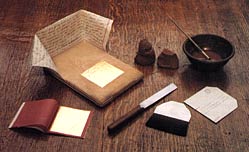
traditional gilders tools24 karat gold is pure gold with no other metal added. Adding small amounts of copper or silver to the gold will change the color of the leaf — and different colors of gold can have the same karat purity. Gold leaf is typically 22-24 karat.
The advantages of gold leaf as opposed to other gold colored finishes include the pure metal's highly reflective quality, its durability (gilded surfaces can last for centuries) and its stability (gold does not tarnish, and is unaffected by water or air).
As described in The Coachmakers' Illustrated Handbook, the traditional technique for beating gold into leaf was a very labor-intensive process:
"The gold is first cast into ingots about three-fourths of an inch wide, and weighing two ounces. The ingot is flattened out into a ribbon of about 1-800ths of an inch by passing it between rollers. This is softened by heat and then cut into pieces of one inch square; 150 of these are placed between leaves of vellum--each piece in the center of a square vellum leaf, another placed above...till the pile of 150 is formed. This pile is enclosed in a double parchment case, and beaten with a 16-pound hammer. The beating is continued until the inch pieces are spread out to four-inch squares; they are then taken out and cut into four pieces, and squares thus produced are placed between gold beaters' skins [membranes stripped from ox intestine], made into piles and enclosed in a parchment ease and beaten as before, but with a lighter hammer. Another quartering and beating produces 2,400 leaves, having an area of about 190 times that of the ribbon, or a thickness of about 1-200,000ths of an inch. An ounce of gold is thus extended to a surface of about one hundred square feet.... After the last beating, the leaves'...ragged edges are cut away, by which they are reduced to squares of 3¼ inches; 25 of these are placed between the leaves of a paper book, previously rubbed with red chalk to prevent adhesion of the gold."
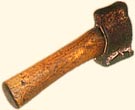
ancient hammer used for
pounding gold into gold leafToday, gold is beaten by machine, producing leaf as thin as 3-millionths of an inch — as thin as a cobweb. At this thickness, gold leaf is extremely fragile and cannot be touched by hand or it will disintegrate. To apply the leaf to the panel, it is first cut to size on a padded leather gilder's cushion, then transferred with a wide brush called a gilder's tip, made of camel hair set in a thin row between two boards. 
book of patent gold
Patent gold is the same quality and thickness as loose gold, but each leaf is mounted on a special tissue paper through a pressure process. This allows the artist to cut the gold with scissors. A book of patent gold leaf is assembled by placing each leaf between sheets of thin rouged paper. The gilder can then remove one leaf a time without disturbing the remaining leaves. A book of 25 gold leaves will cover a flat surface area of about 2 square feet without waste or overlap.
top of pageBURNISHERS,
PUNCHES & STYLUSES 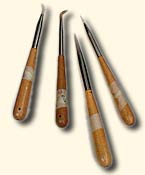 When
gold leaf is first laid onto a gessoed panel, its surface is a rather dull and lusterless yellow. Creating gold's characteristically bright appearance requires the use of a burnisher. This tool is essentially a hard, smooth, highly polished stone — historically a carnivorous animal's tooth or polished hematite and now mostly agate — mounted on a wooden handle. Burnishers come in various sizes and three basic shapes: flat, toothed and pencil. The smallest are for working in gilded corners
and crevices.
When
gold leaf is first laid onto a gessoed panel, its surface is a rather dull and lusterless yellow. Creating gold's characteristically bright appearance requires the use of a burnisher. This tool is essentially a hard, smooth, highly polished stone — historically a carnivorous animal's tooth or polished hematite and now mostly agate — mounted on a wooden handle. Burnishers come in various sizes and three basic shapes: flat, toothed and pencil. The smallest are for working in gilded corners
and crevices.
Burnishing changes the appearance of the gold by compacting and hardening the surface while smoothing out any imperfections in the leaf. Burnishing does not remove any metal.
Burnishing is accomplished by first pressing 
punch designs the tool lightly onto the gold and moving it in a gentle, circular motion. This rubs out any roughness in the overlapping gold leaves. After a few minutes, once it's clear the gold is completely dry and adhered to the panel, the tool is moved in a back-and-forth motion (all strokes in one direction) over the entire surface using a firmer pressure. The gold is then pressed even more firmly with strokes running in the opposite direction. Gauging the correct pressure comes from experience — too little will not yield
a high sheen, too much will rub off the leaf. This procedure is continued until the gold has achieved a flat, even, mirror-like surface.
A stylus, a pointed metal tool originally used for inscribing wax or clay, is used in tempera painting to carefully remove the paint from a gessoed panel in order to make corrections.
Punches, hard metal rods with a letter or design embossed on one end, are used to stamp designs into the burnished gold surface. Historically used to delineate and decorate the halos of saints and to create patterns on garments and backgrounds, punching strengthens the gold's metallic quality by creating a reflective, sparkling surface out of a flat area of metal.

modern agate burnisherTo use a punch, it is struck sharply with a mallet
or strip of hard wood. The smaller the punch face, the lighter the stroke it
requires so as not to break through the gold. A large punch needs a heavier stroke
to impress the design into the gilded gesso.

